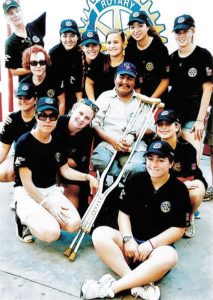El Granada resident Evelyn Moseley, 16, knew only a little Spanish, but had no problem connecting to the young woman in Mazatlan, Mexico, whom she had just lifted into a wheelchair.
In halting Spanish, Moseley asked the Mexican girl about herself — and learned they shared much in common. “I asked her age, and she said 16, and that moment hit me because it (related) to me,” she said. “I imagined my life if I was in that kind of situation. It made me really think more.”

Photo courtesy Millie Golder
The Half Moon Bay Interact Club with adults Millie Golder and Darcie Galle, pose with a wheelchair recipient in Mazatlan. Top row from top left, a Foster City Rotarian, Golder, Rose Logan, Emily Kelley, Melissa Kalkin, Genna St. Andrew, Lena King; bottom row, Liana Brinkmeier, Galle, Colleen Flynn, the wheelchair recipient, Anita Oettel-Flaherty and seated in front, Simone Vadroff. Not pictured: Evelyn Moseley, Steve Wilson.
The situation that brought Moseley to Mexico depended on those kind of connections. Moseley visited Mazatlan with the Half Moon Bay Interact Club Nov. 11 through Nov. 15. She is the president of the club and was on a humanitarian trip that included wheelchair distribution.
Interact is a youth contingent of Rotary International focusing on humanitarian work. The Coastside teens are part of the 80-plus-member Half Moon Bay Interact club, under the guidance of Half Moon Bay Rotarian Millie Golder.
The activities and fundraisers in which the club has been involved, locally and beyond, include brown-bag lunch distribution to the homeless in San Francisco, Adopt-a-Family, beach cleanups, the Teddy Bear Clinic, Candy Land, Rotary regional activities and more.
The club earmarked $3,000 for wheelchairs and school supplies for this, the fourth trip to Mazatlan.
Besides Moseley, local Interactors who made the trip included Liana Brinkmeier, Colleen Flynn, club Vice President Melissa Kalkin, Emily Kelley, Lena King, Anita Oettel-Flaherty, Genna St. Andrews, Rose Logan and Simone Vandroff.
The local teens were chosen for the trip on the basis of their community service hours through club work and were accompanied by Golder, her daughter Darcie Galle and fellow Rotarian Steve Wilson. They were part of a larger group that included members of the Foster City Rotary Club and Interact, under the auspices of the Rotary Wheelchair Foundation and under strict rules protecting the teens.
The trip opened a window into another world for the teens.
“When they leave their parents and go through the gate at San Francisco International Airport, they come back different people when they come through those gates again,” said Golder. “They come back realizing how fortunate we are, how lucky we are to live here.”
During the trip, the Interactors visited local schools supported by the Foster City Rotary club, handing out school supplies and “humanitarian bags” packed with toys for the children, soccer uniforms and trophies for the teens and adult items like cosmetics. They also visited an orphanage that served infants to 18-year-olds.
There was time for fun with Mazatlan peers when the Interactors faced locals for a friendly soccer game. But the heart of the trip was the wheelchair distribution at a large public gym, when the teens assembled around 125 wheelchairs and handed them out to users whose families brought them to the gym.
To reach the many, often bedridden wheelchair users unable to get to the gym, Interactors and adults traveled to frequently impoverished homes, where they were met with tears of gratitude.
It was on one such home visit that Kalkin, also 16, came face to face with what the Mazatlan trip was all about. She had had some idea of what to expect from elder sister Kristin, a recent Half Moon Bay High graduate also involved with Interact. But her sister’s words did not prepare her for all she would feel as she lifted an elderly woman into a new chair.
“The first person I put in a wheelchair was big for me,” said the El Granada teen. “I didn’t understand how much it would impact me, to see how happy they are” to get their chairs.
Often, the Interactors said, the tears of gratitude came from not just recipients and families but caregivers as well.
There was also dinner with the Mazatlan city council and a side trip to paint an elementary school.
And there were the memories, which did not fade.
“It was life-changing,” said Kalkin, noting that the Mazatlan residents she observed seemed happy, even amid poverty. “It was really moving and made me appreciate what I have. If they can be happy with the little they have, I can too, and I appreciate my family more.”
“It made me a more compassionate person, made me live life in a way to be more grateful, more happy in general,” said Moseley.
Making the trip to help the Mazatlan people, she said, was “so different, you can’t compare it to anything else. In the future, I want to experience that feeling as much as I possibly can.”
SOURCE: Half Moon Bay Review
 But now she can go out freely to the vivid outside world in the wheelchair sent free by the Chengdu Disabled Persons’ Federation. She can often go downtown or to the market, talk with the villagers and witness the change around her. The wheelchair gives her the possibility to enjoy the bright sunshine, the colorful world and the warm love as well as improve the quality of her life.
But now she can go out freely to the vivid outside world in the wheelchair sent free by the Chengdu Disabled Persons’ Federation. She can often go downtown or to the market, talk with the villagers and witness the change around her. The wheelchair gives her the possibility to enjoy the bright sunshine, the colorful world and the warm love as well as improve the quality of her life.
 But Kurt had other plans. He would thrash around with his hand over and over again until he could grab the window sill next to his bed. After a few weeks, he could raise his slender frame up high enough to see the ocean. Ten months of struggle put him back on his feet, although he would need crutches and patience to take even a few steps.
But Kurt had other plans. He would thrash around with his hand over and over again until he could grab the window sill next to his bed. After a few weeks, he could raise his slender frame up high enough to see the ocean. Ten months of struggle put him back on his feet, although he would need crutches and patience to take even a few steps.
